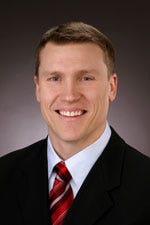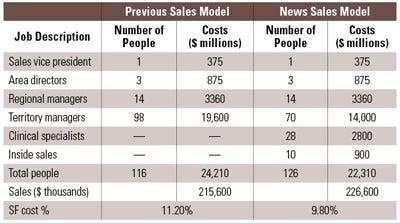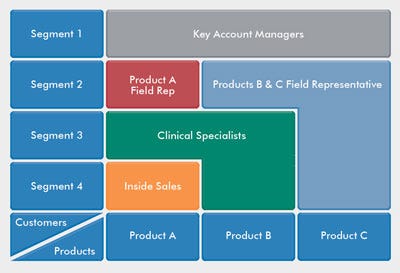Tremendous external pressures are driving medical device manufacturers to reduce prices and provide more value to customers. Hospitals remain under considerable financial stress and as a result are demanding discounts from suppliers, scrutinizing capital expenditures, and reexamining new technology purchases. To make matters worse, Wall Street continues to expect steady sales and growing profits from the device industry. In order to maintain double-digit growth in this business environment, device manufacturers need to pare expenses.
|
Peter Masloski |
Taking a hard look at ways to cut costs and improve efficiency, many medical device companies are reexamining their sales channels. Cost-cutting ideas include substituting traditional field sales roles with more effective channels or changing to less-expensive sales roles than the use of field representatives.
Because companies can struggle to implement these new sales models properly, they often fail to live up to expectations. However, when implemented correctly, sales model changes can have a positive impact on both the top and bottom lines. This article explores three separate sales configurations and the paths that device and diagnostic companies can take to use them effectively.
Hybrid Sales Structures
In addition to traditional field territory managers, some of the most successful sales models are hybrid structures such as the key account manager (KAM) model, field support specialist (FSS) model, and inside sales (IS) representative model. Additionally, there are a number of innovative variations on how these roles are being deployed to improve sales performance.
Correctly implemented, any one of these sales concepts above can be very effective. The benefits and methods of implementation for each model follow below:
Key Account Manager. Faced with increasing competition, product commoditization, and price-sensitive hospitals, medical device company executives often believe they have only one option to stay competitive: Lower prices or risk losing market share. Integrated delivery networks (IDNs) and regional purchasing groups often request “one face” (i.e., a single point of contact) for the company. In many cases, a KAM with responsibility for products from across the company’s entire portfolio will fulfill this request.
|
Bret Caldwell |
Implemented correctly, the KAM concept embodies a familiar refrain at many companies: If we could do a better job reaching higher-level decision-makers—and our salespeople could do a better job communicating our company’s overall value proposition—we could continue to grow and add value without cutting prices. However, many KAMs struggle to differentiate their company based on value, and the vast majority of their customer focus is on negotiating the amount of discounts or driving compliance within existing contracts by using discounts as the dominant leverage point.
Therefore, success with a KAM program requires the right alignment between vision and implementation. In order for KAMs to be strategically successful, they must have a clear value proposition and be supported with appropriate tools and training. It is also important to have the right person in the role, someone who has the appropriate skills to succeed because the KAM role demands advanced business skills in negotiation, strategy, pricing, presentation, analytics and teamwork. Simply placing a successful field representative into the KAM role is usually a recipe for disaster. However, when the role is implemented well, the KAM can leverage the company’s full product portfolio and service offerings, providing the company high sales growth and profit while also saving costs and improving customer service.
In addition, some companies have expanded the KAM role by defining a “key account” as any large hospital biased toward centralized purchasing and the ability to maintain compliance. Although this change is subtle, expanding the definition of a key account beyond IDNs allows the KAM to avoid wasting time on IDNs with fragmented decision processes or IDNs that don’t generate improved sales volume, or both. This definition of a key account can also lead to discovering customers with less competition (i.e., that are not targets of other companies’ KAMs) and with similar or better upside potential than some IDNs.
|
Table I. Sales model updates can improve top- and bottom-line performance. In this example, the company's new model has 28 fewer territory managers, while the firm adds a total of 38 clinical specialists and inside sales reps to its sales force. Headcount and sales increase, while costs and sales force costs as a percentage of sales go down. SF refers to sales force. |
Value-Added Programs
KAMs can also be quite effective when implementing value-added programs or reaching high-level decision-makers. Examples include business development programs that help hospitals build profitable service areas (such as bariatrics or cardiology) or that implement long-term cost-saving technologies such as peripherally inserted central catheters or infection-control devices. KAMs can be especially effective when savings lie outside the department of the primary purchasing decision-maker. The KAM can sell the cost-savings message at a high level upfront, and the account manager will often monitor and report post-implementation savings to reinforce the company’s value to the hospital.
Implementing a successful KAM program requires an organization-wide commitment. Different business units represented by the KAM team need to have sales incentives aligned so that individual units do not resist giving price discounts for the benefit of others, and so that the KAMs are motivated to coordinate with the product-focused sales force.
Field Support Specialist. One of the most successful strategies for reducing the cost of sales—without affecting the sales force’s impact—is to deploy field support specialists.
Although there are many other ways to shape and implement this role, the most common version of the FSS is the Clinical Specialist (CS). Deploying a CS helps reduce selling costs by covering surgical cases and other clinical support activities with a less-expensive but still capable resource, which frees sales representatives to prospect and sell. The financial impact of the CS can be substantial (see Table I).
Other successful FSS variations focus on freeing sales representatives from time spent on nonsales activities, or by providing on-demand “stretch” capacity to the field when needed. Administrative support representatives, for example, can provide efficient help when the sales process involves significant nonselling administrative activities. These activities include account profiling, sample delivery, appointment scheduling, contract management, equipment maintenance or delivery, order fulfillment, and inventory management. If access to the operating room suite is a concern, significant ongoing case coverage is needed, or if there is concern about inappropriate sales promotion in the OR, providing in-service representatives focused solely on providing clinical support to OR surgeons can be an effective strategy.
Manager Buy-In
Successful design of these support roles demands that management has a thorough understanding of the sales process so that it can appropriately segment activities and accurately determine workload estimates in order to predict resource requirements. First-line managers must also buy into the roles and be trained to coach and manage them. Adding such roles often requires more communication and coordination than traditional structures. Well-designed support tools, such as shared calendars, account plans, activity data and contacts, can also be critical to successful implementation.
Failure with these support roles often stems from poor sales model design. A common mistake is having the specialists report to different first-line managers than the field salesperson, which usually leads to poor communication and coordination. There is also a strong temptation to treat these roles as entry-level stepping-stones to a field representative role. However, the support role requires skills that are often significantly different from a field representative’s. Failure to properly define the job profile can lead to potentially dangerous skill and experience gaps.
|
Figure 1. Incremental sales roles need to be clearly defined and coordinated to suit the company segment, product, and client requirements. Segment refers to customer account segment. |
Although it is possible for support representatives to make the transition to the field, the hiring profile for each position is typically different; there may be turnover if support representatives expect they will become field representatives but do not.
Inside Sales. The use of inside sales is one of the most effective ways to increase customer reach and keep costs low. Surprisingly, many companies are apprehensive about considering inside sales. Executives often believe that medical sales are too complicated to be accomplished over the phone, or that key decision-makers cannot be reached effectively by telesales. However, experience shows that inside sales—designed and deployed correctly—can be effective in nearly all medical markets.
Salary Savings
Some companies use inside sales to cover remote hospitals or low-value hospitals in any geographic region, or both. Others use the inside sales model to implement specific steps of the sales process where face-to-face interaction may not be critical. These functions include prospecting, information collection, administrative tasks, and issue resolution.
Regardless of the salesperson’s role, a well-executed inside sales program almost always yields better-than-expected results because salary and expenses are often 50% or more lower than they are for field representatives. Furthermore, inside sales programs are often at least 75% more effective and cover far more customers than field representatives who must drive from hospital to hospital.
To help ensure successful use of this model, it is critical that company managers clearly define what’s expected in terms of role, metrics, customer service, and related responsibilities. Expected productivity (measured by call volume, call duration and other metrics) and impact (such as sales and leads generated) should be estimated up-front and measured with appropriate management reports or dashboards. This role should be viewed and staffed with professional salespeople, and not, for example, with those who only have customer service experience. Inside sales is an important sales role that happens to be based on the phone rather than in the field.
Management also needs to support inside sales with strong training (often the same product training as field representatives), customized marketing programs, and appropriate variable-incentive compensation plans. In addition, management must offer processes and tools to facilitate coordination and communication between inside sales and field sales representatives. The most successful programs are initiated with pilot testing, which helps the organization learn what works. Company management must also first measure representative and support system capacities before finalizing a plan for national rollout.
Time for Reevaluation
The sales force is one of the largest single cost items on the ledger of a medical device company, but it is essential for revenue growth. To stay competitive, it is critical that company executives reevaluate their sales models and challenge their sales organizations to improve effectiveness and reduce costs. Even companies that are growing rapidly should take a hard look at their sales roles in order to ensure efficient and effective coverage of the market (see Figure 1).
One or more of the roles mentioned in this article are appropriate for all medical device companies, and several new roles are appropriate in many circumstances. As manufacturers develop strategies to adapt to the current tough market, many will need to improve their sales models. As these examples show, executives can do this by adding new roles or by redefining existing ones to ensure that one of their largest investments—the sales channel—is as effective as possible.
Pete Masloski is the leader of the medical products and services practice for ZS Associates (Chicago), a global business consulting firm. Bret Caldwell is a company principal focusing on medical products and service clients.
About the Author(s)
You May Also Like






